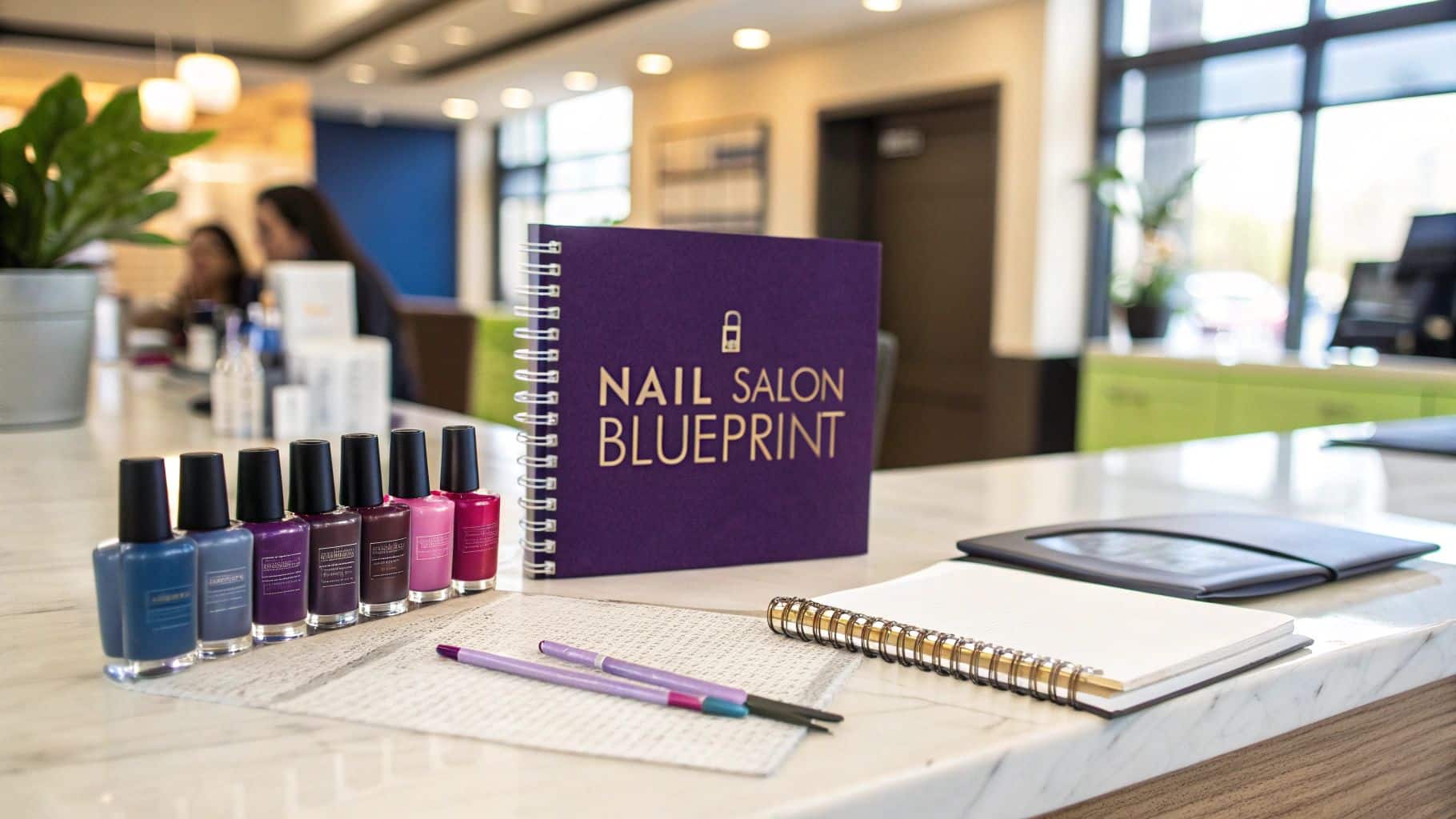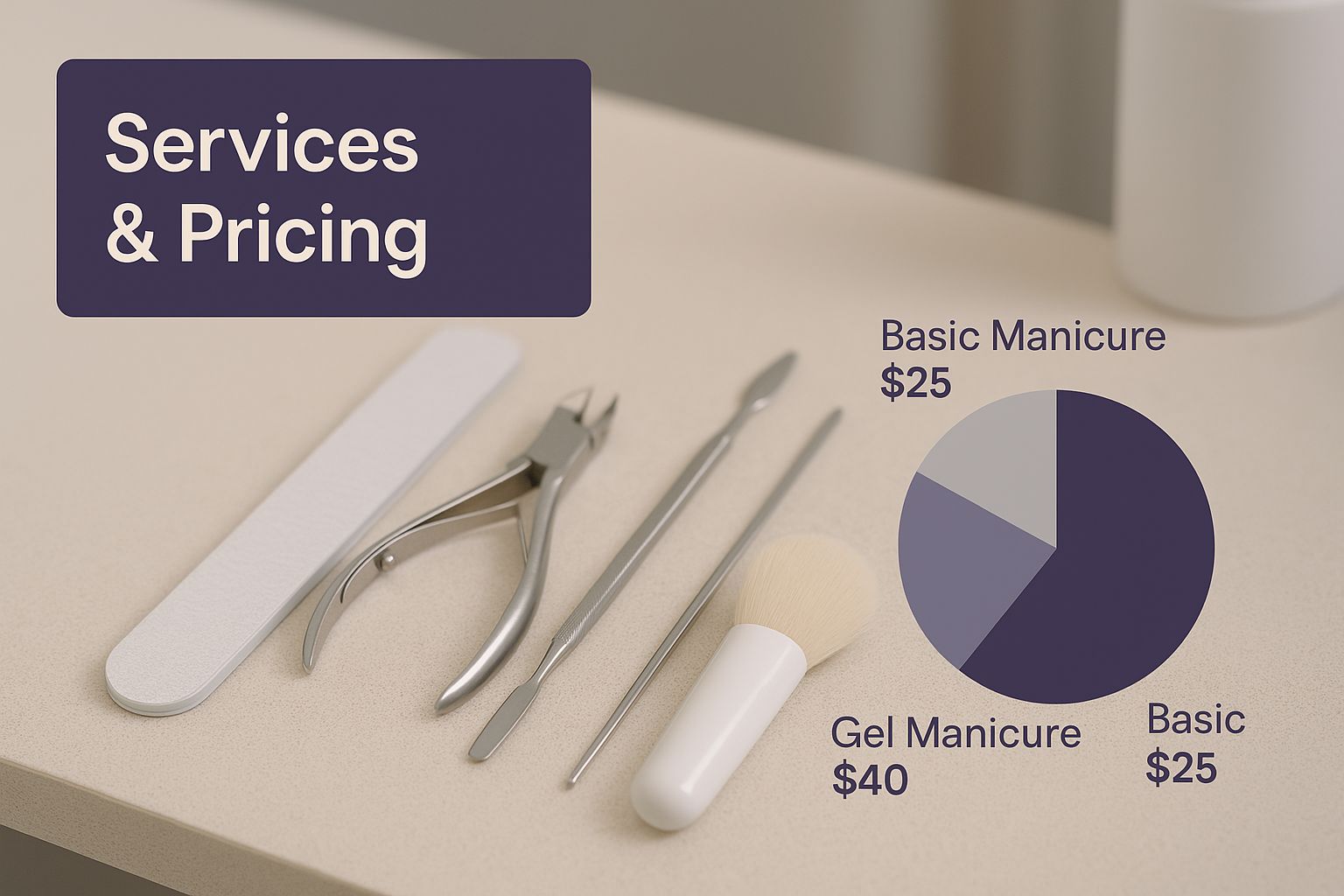Nail Salon Business Plan Template for Success

It's easy to think of a nail salon business plan template as just another boring form to fill out. That’s a huge mistake. A better way to see it is as your salon's strategic playbook—it’s the very first and most powerful tool you have for turning a passion for nail art into a profitable, thriving business. This is where you lay the essential groundwork for a brand that actually lasts.
Your Business Plan Is Way More Than a Document
Let go of the idea that a business plan is some dusty stack of papers you create once for a bank loan and then shove in a drawer. If you're serious about opening a salon, this document becomes your active, living guide. The real magic isn't in the final paper, but in the process of thinking through every single detail—from who your dream client is to how you'll budget for marketing. That’s what builds a rock-solid foundation for success.
The beauty industry is notoriously competitive, and trends can change in the blink of an eye. A well-crafted business plan gives you the clarity you need to navigate all of that noise. It forces you to get crystal clear about what makes your salon different. Are you going to be the go-to spot for wild, intricate nail art? Or maybe you'll be the only salon in town using exclusively non-toxic, vegan products. Nailing down these answers early is absolutely critical.
Setting the Stage for Success
A strong business plan does more than just organize your ideas; it validates them. It’s your chance to prove—first to yourself, and then to everyone else—that your vision is actually viable. Going through this process helps you:
- Secure Funding: Lenders and investors need to see you’ve done your homework. When you walk in with a detailed plan showing realistic financial projections and a deep understanding of your market, you're showing them you're a low-risk investment.
- Attract Top Talent: The best nail techs aren't just looking for a job; they want to be part of a salon with a clear vision and a plan for growth. Your business plan is a powerful tool to communicate your brand's mission and attract professionals who are just as passionate as you are.
- Make Smarter Decisions: When you’re faced with tough choices—like how to set your prices or how much to sink into that new ad campaign—your business plan becomes your North Star. It gives you a benchmark to measure your progress and keeps you on track.
Actionable Insight: A business plan isn't about predicting the future with 100% accuracy. It's about preparing for it. Use it to spot potential challenges early, set goals you can actually hit, and build the confidence you need to lead your business forward.
From Passion to Profitability
At the end of the day, writing your nail salon business plan is the first real, tangible step on your entrepreneurial journey. It’s the moment your creative passion starts to transform into a structured, profitable business. By taking the time to map out your strategy, you’re not just creating a document; you’re building the framework for a resilient brand that can thrive for years to come. This is where your dream starts to take shape.
Crafting a Compelling Executive Summary

Think of your executive summary as the highlight reel for your entire nail salon business plan. It's the very first thing a potential investor, partner, or lender will read, and you've got about one page to get them hooked.
This is why you should always write this section last. It might feel counterintuitive since it sits at the front of your document, but you can only summarize the good stuff after you've figured it all out. Once you've done the hard work, you can pull the most powerful details—your mission, financial goals, and what makes you special—into a single, compelling snapshot.
Its job isn’t to give away the whole story. It’s to make them so intrigued they have to keep reading.
Defining Your Salon's Core Mission
Your mission statement is the soul of your salon, and it belongs right at the top of your executive summary. It’s more than just "doing nails." It’s a short, punchy declaration of why you exist and the unique experience you're bringing to your clients and community.
To nail it down, here’s an actionable exercise. Answer these questions:
- What problem are you solving? Is there a gap in the market for affordable luxury? Or maybe no one in town offers non-toxic, kid-friendly manicures?
- Who are you serving? Are you a haven for busy professionals who need flawless express services, or are you creating a pampering escape for clients who want to unwind?
- What makes you different? Is it your next-level nail art, your commitment to eco-friendly products, or a killer membership model?
For example, if you're targeting the on-the-go crowd, your mission might sound like this: "To provide time-crunched professionals in downtown Boston with impeccable express manicures and pedicures in a chic, modern setting." Right away, this tells a reader who you are, where you are, and what you do best.
Key Takeaway: Your mission statement should be the first paragraph of your executive summary. It sets the stage for everything that follows and instantly communicates your brand’s identity and purpose.
Highlighting Your Unique Selling Points
Okay, you've shared your mission. Now you need to back it up with the "how." This is where you spotlight the key elements that make your salon a fantastic investment. Think of it as your highlight reel, covering the most impressive parts of your plan.
For an effective summary, briefly touch on these pillars:
- Services and Specialization: Mention your signature services. Are you the go-to spot for Gel-X extensions, intricate hand-painted designs, or deluxe spa pedicures with all the add-ons? Let them know.
- Target Market: Quickly describe your ideal customer and why they're hungry for what you're offering. Adding a hard number gives this weight. For instance, "Our salon is located in a zip code with a 35% higher than average household income."
- Competitive Advantage: What's your secret sauce? Maybe it's a prime location with tons of foot traffic, an exclusive partnership with a popular local boutique, or a team of award-winning nail techs you’ve already recruited.
- Financial Snapshot: Give them the top-line numbers. No need for dense spreadsheets here, just the headlines. Include your projected revenue for the first year, how much funding you're asking for, and when you plan to be profitable. For example: "We are seeking $75,000 in startup capital to cover our salon build-out and initial operating costs, and we project reaching profitability within 14 months."
When you weave these points together, you’re not just sharing a dream. You’re presenting a viable, well-researched business opportunity that makes an investor feel confident, not hesitant. This turns your nail salon business plan from a simple document into a powerful tool for getting the "yes."
Sizing Up Your Market and Competition
To make it in the nail industry, you can't just be good at what you do—you have to be a savvy business owner. That starts with getting a real, on-the-ground understanding of your local market. Forget abstract analysis; we're talking about practical research that will directly shape your salon's strategy and set you up for success.
You need to figure out who you’re actually serving. Are they busy professionals who need a quick, perfect manicure on their lunch break? College students looking for the latest wild nail art? Or maybe families who need a salon that’s kid-friendly? We'll walk through how to figure this out, scout your competitors (like a total pro), and most importantly, find those golden opportunities they've missed.
Maybe there's no one in town doing high-end, intricate nail art, or perhaps every salon is still using harsh chemicals. Spotting these gaps is how you go from being just another nail salon to the go-to spot for a specific, unmet need.
The visual below breaks down how to think about the services and pricing part of your nail salon business plan template, which is a direct result of solid market research.

As you can see, clearly defining what you offer and what you charge is a critical piece of the puzzle, and it all starts with knowing your market inside and out.
Pinpointing Your Ideal Client
Before you even think about ordering polish, you need a crystal-clear picture of your ideal client. This isn't just a vague idea; it's a detailed profile that will guide every single decision you make, from the music you play to the ads you run.
So, who are you trying to attract? Are you aiming for high-income professionals who value speed and perfection and don't mind paying for it? Or are you targeting a younger crowd that’s all about expressing themselves with trendy, budget-friendly designs?
Get specific by digging into demographics. You can use free tools like the U.S. Census Bureau's data explorer to check out the median income, age ranges, and population of your target neighborhood. This isn't just boring data—it’s a goldmine. An affluent area might be the perfect place for luxury spa pedicures, while a neighborhood packed with young families could be crying out for a salon that offers non-toxic, kid-friendly polish options.
Once you have the data, bring your ideal client to life by creating a persona. Give them a name, a job, and a lifestyle. For instance:
- Name: "Corporate Chloe"
- Age: 32
- Occupation: Marketing Manager
- Needs: She needs a durable gel manicure that looks flawless through a full week of client meetings. Chloe is busy, so she lives by online booking and will happily pay a premium for convenience and top-notch quality.
When you get this detailed, you can design an experience that Chloe will absolutely love. She won't just be a one-time customer; she'll become a loyal regular who tells all her friends about you.
Scouting the Competition
Knowing your competition means more than just knowing their salon's name. It's about becoming a student of their business so you can spot the opportunities they've completely overlooked. Your mission, should you choose to accept it, is to go undercover as a "secret shopper" and gather some firsthand intel.
Whip up a simple spreadsheet to keep your notes organized. Then, visit the top 3-5 nail salons in your desired area.
Here’s a checklist for what to look for:
- The Vibe Check: What’s your first impression? Is the salon sparkling clean and modern, or is it dated and chaotic? How does it make you feel?
- Services & Pricing: Grab a price list. What do they offer? What do they charge? Pay close attention to their most popular services and anything that seems unique.
- The Client Experience: How are they treating people? Are the technicians skilled and friendly? Was it a pain to book an appointment, or was it seamless?
- Their Digital Footprint: Check out their website and social media profiles. Are they active? What are people saying in the reviews?
This kind of on-the-ground research is where you’ll find the gaps. Maybe you'll notice every salon uses products with harsh fumes, creating a perfect opening for an all-natural, eco-friendly spa. Or maybe nobody is offering the detailed, hand-painted nail art that’s all over Instagram. Understanding what makes you different is everything. If you want to dive deeper, learning about mastering brand positioning will help you carve out your unique space in the market.
Pro Tip: Your competitive analysis isn't just about finding their weaknesses. It’s also about recognizing what the top salon in town does exceptionally well. If they're famous for five-star customer service, that's the bar you need to meet—or exceed.
The global nail salon market is booming, projected to hit $14.38 billion in 2025. North America makes up a huge piece of that pie, with about 19.8% of the global share. That's expected to grow from $2.85 billion in 2025 to $4.62 billion by 2033, with the U.S. market accounting for over 80% of that. This isn't just trivia; it shows a healthy, growing industry that’s ripe with opportunity for smart entrepreneurs who do their homework.
Designing Your Services and Pricing Strategy

Let’s talk about the engine of your salon: your service menu and pricing. This isn't just a list of manicures and pedicures; it's the strategic core of your business, designed to make every client visit as profitable as possible. Simply offering the basics won't cut it if you want to build a resilient, thriving salon.
This part of your nail salon business plan template is where you get creative and design a menu that speaks directly to the ideal client you've already identified. The real magic happens when your menu not only meets their needs but also tempts them to indulge a little more, boosting that all-important average ticket value.
Building Your Core Service Menu
First things first, nail the essentials. What are the absolute must-have services your target clients expect? We're talking standard manicures, pedicures, and the ever-popular enhancements like gel polish or acrylics. These services are the foundation of your menu—your bread and butter.
Once you have that solid base, it's time to get strategic. Think about creating service tiers that appeal to different needs and budgets. It's a classic upselling technique that feels natural and helpful, not pushy.
Here’s a simple framework you can implement:
- The Express: Perfect for the busy professional on a lunch break. This is a quick, no-fluff service—think file, shape, buff, and polish. It gets them in and out looking great.
- The Signature: This is your high-quality, go-to service. It should include meticulous cuticle care, a relaxing hand massage, and a flawless polish application. This will likely be your most popular booking.
- The Deluxe: This is the ultimate spa escape. Elevate the experience with an exfoliating scrub, a hydrating mask, an extended massage, and maybe a paraffin wax treatment. It’s a high-margin service that makes clients feel truly pampered.
With tiers like these, upselling becomes an organic part of the conversation. When a client books your "Signature" service, it’s easy for your tech to ask, "Would you like to upgrade to our Deluxe package today? It includes our seasonal sugar scrub and a hot towel treatment."
Maximizing Profit with Add-Ons and Retail
This is where you can really see your revenue climb. Lucrative add-ons are small, high-margin services that don't add much time to an appointment but add significant value for the client. And I'm talking about more than just a French tip.
Get creative with your add-on menu:
- Intricate, hand-painted nail art, priced per nail or by complexity.
- Gel-X extensions, a hugely popular and premium alternative to traditional acrylics.
- CBD-infused lotions for an upgraded massage experience.
- Collagen hand or foot treatments for an extra touch of luxury.
And please, don't sleep on retail. It's a massive, often overlooked opportunity to create a second income stream and extend your brand's presence beyond the salon. The key is to select a product line—polishes, lotions, cuticle oils—that genuinely aligns with your brand. If you're positioning yourself as an eco-conscious salon, carry a vegan, non-toxic product line that you and your techs believe in.
The global nail care market, which includes products sold online, is projected to reach $24.73 billion in 2025 and grow to $35.97 billion by 2032. That's proof that clients are already buying these products somewhere—it might as well be from you! For more insights on how to get started, you can check out our comprehensive guide on how to start a nail salon.
Actionable Insight: Don't just stick products on a dusty shelf and hope for the best. Train your technicians to use your retail products during the service and casually explain the benefits. If a client loves the scent of the lotion used in their massage, they’re halfway to buying a bottle on their way out.
Here’s a look at how you might structure your revenue streams to ensure you’re not relying on just one type of service.
Sample Nail Salon Revenue Stream Breakdown
This table illustrates a potential revenue mix for a new nail salon, showing how to diversify income beyond basic services.
| Revenue Stream | Description | Target % of Total Revenue |
|---|---|---|
| Core Services | Standard manicures, pedicures, gel polish applications. The foundation of your business. | 50% |
| Premium Services | Deluxe spa packages, Gel-X extensions, acrylic sets. Higher-margin, luxury offerings. | 25% |
| Add-Ons | Nail art, paraffin treatments, upgraded massages, repairs. High-margin, low-time additions. | 15% |
| Retail Products | Polishes, lotions, cuticle oils, nail care kits. A crucial secondary income stream. | 10% |
By planning your revenue mix this way, you create a more stable and profitable business model from day one.
Calculating Your Cost-Per-Service
To set prices that actually make you money, you have to know exactly what each service costs you to perform. Pricing based on guesswork is a fast track to burning out and closing your doors.
Here is a practical, step-by-step method to calculate your cost-per-service:
For a standard gel manicure, your calculation would include:
- The cost of all disposable items (e.g., files, cotton, foils).
- The cost of the actual product used (a few drops of base coat, color, top coat, cuticle oil).
- A portion of your technician's commission or hourly wage for the time that service takes.
Once you have that cost, you can set a retail price that guarantees a healthy profit margin. This is a non-negotiable step for your business plan, ensuring every appointment makes a positive contribution to your bottom line. And remember to revisit these numbers periodically—supplier prices change, and your pricing should, too.
Your Plan to Attract and Retain Clients
A gorgeous salon and perfect manis are a fantastic start, but they don't pay the bills on their own. The real lifeblood of your business is a steady, reliable stream of clients—the kind who don't just visit once, but come back again and again. This section of your nail salon business plan template is your game plan for making that happen. It’s where you’ll map out exactly how you'll get new customers in the door and, just as crucially, how you’ll turn them into loyal fans.
We're going to focus on a practical mix of modern digital moves and proven local strategies you can start planning right now. Let's be real: a beautiful Instagram feed isn't optional anymore; it's your salon's living, breathing portfolio. A well-played grand opening can create an instant buzz that fills your appointment book from day one.
Creating Your Pre-Launch Buzz
Your marketing hustle should start long before you even open your doors. Building anticipation is one of the most powerful tools you have. Get those social media profiles set up, especially on visual-first platforms like Instagram and TikTok. This is where you'll start telling your brand's story.
Post "behind-the-scenes" content of your salon's build-out. Share sneak peeks of your gel color wall, your plush pedicure chairs, or even videos of your team training on the latest techniques. This forges a connection with potential clients before they can even book an appointment.
Next up, plot out a grand opening campaign with these actionable steps:
- Team Up with Local Influencers: Find micro-influencers right in your town. Offer them a complimentary service in exchange for posts about their experience and your upcoming launch. It’s authentic and effective.
- Run a Pre-Opening Giveaway: Host a contest on your social channels where followers can win something awesome, like a "VIP package" for your opening week. This is a brilliant way to build your follower count and create a hot list of engaged potential clients.
- Connect with Neighboring Businesses: Go introduce yourself to the non-competing businesses nearby—the local boutique, the popular coffee shop, the hair salon down the street. Offer them a stack of grand-opening discount cards to share with their customers.
These early moves lay the groundwork, ensuring you have people hyped up and ready to book the second your online system goes live.
Modern Tools for Client Management
In today's world, convenience is everything. A clunky booking process or radio silence on communications can lose you a client before they ever set foot in your salon. Using modern salon management tools isn't a luxury; it's absolutely essential for giving clients a seamless, professional experience.
An online booking system is completely non-negotiable. It lets clients book appointments 24/7, which means less phone tag for them and less admin work for you. Even better, these systems can send automated appointment reminders via text and email, a feature that has been shown to dramatically slash costly no-shows.
You should also use simple email marketing to stay top-of-mind. You don’t need to craft complicated campaigns. A simple monthly newsletter announcing new services, seasonal promotions, or last-minute openings can drive a surprising amount of repeat business. It's a direct line to your most valuable customers.
Key Insight: The goal of your marketing isn't just to get one appointment; it's to start a relationship. Every single interaction, from their first follow on Instagram to their post-manicure thank-you email, should be designed to make that client feel seen and valued.
Building Trust and Fostering Loyalty
Once you've got clients through the door, keeping them is where the real profit is made. It costs way more to acquire a brand-new customer than it does to keep a current one happy. Loyalty starts with an amazing service, but it's secured by everything that happens after.
Get proactive about asking for online reviews. After a client's appointment, send a friendly follow-up email with a direct link to your Google Business Profile or Yelp page. Positive reviews are a massive trust signal for new clients checking you out. Don't be shy about asking—happy customers are usually more than willing to share their great experience.
Finally, set up a referral program. Turn your happiest clients into your best marketers by rewarding them for sending new business your way. It could be a discount on their next service or a freebie like a nail art add-on. This creates a powerful, self-sustaining cycle of word-of-mouth marketing. For a deeper look, you can explore some proven customer retention strategies to build a truly loyal fanbase.
The strategies for attracting clients to a nail salon share many principles with other beauty businesses, like spas. If you’re ever thinking about expanding your services down the road, learning how to start a spa business can offer even more valuable insights into client acquisition and retention in the wider beauty industry.
Mapping Out Your Financial Future
This is where your glittery, creative vision for a nail salon meets the real world of numbers. The financial section of your business plan can feel like the scariest part, but don't sweat it. Think of it as simply telling your salon's story with numbers—and for any lender or investor, this is the chapter they care about most. It’s what proves your salon isn't just a passion project; it’s a smart, viable business.
We're going to break this down into three key pieces: your startup cost list, your profit and loss (P&L) forecast, and your cash flow projection. These aren't just boring spreadsheets. They're the roadmaps that will give you the confidence to lead your business and wow anyone you're asking for money.
Nailing Down Your Startup Costs
Before you can even dream about profits, you have to get crystal clear on what it will cost to open your doors. This number is the bedrock of your entire financial plan. It's so important to be obsessive about the details here, because underestimating your startup costs is one of the fastest ways a new salon can run into trouble.
To get an accurate picture, list your expenses in two buckets:
- One-Time Costs: These are all the big, initial investments you'll make to get the salon ready for its debut. Think security deposits on your lease, the cost of renovations, those gorgeous professional pedicure chairs, your manicure stations, and that first huge haul of polishes and supplies.
- Recurring Costs (for the first 3-6 months): You absolutely need a cash cushion to cover your bills before you start bringing in steady money. This includes things like rent, utilities, payroll for your first nail techs, monthly software subscriptions for your booking system, and the marketing budget for your grand opening.
Crucial Tip: Whatever your final number is, add a 15-20% contingency fund on top of it. Seriously. This isn't just "padding the budget"—it's a realistic buffer for all the things you can't predict. A surprise plumbing issue, an unexpected permit fee, you name it. This safety net can literally save your business in those fragile first few months.
To get your wheels turning, here’s a sample breakdown of what your own list might look like.
Startup Cost Estimate for a Nail Salon
This table provides a sample breakdown of one-time and recurring startup expenses to help you budget effectively for your new salon.
| Expense Category | Estimated Cost Range (One-Time) | Notes and Key Considerations |
|---|---|---|
| Lease & Build-Out | $5,000 – $35,000+ | Includes your security deposit, first month's rent, and any necessary construction or cosmetic renovations to create your dream space. |
| Furniture & Equipment | $10,000 – $40,000 | This covers your big-ticket items: pedicure chairs, manicure stations, reception desk, sterilization equipment, and comfy waiting area furniture. |
| Initial Inventory | $3,000 – $10,000 | All your polishes, gels, powders, lotions, disposable supplies (like files and buffers), and any retail products you plan to sell. |
| Licenses & Permits | $500 – $2,000 | Don't forget the boring but essential stuff: your business license, cosmetology establishment license, health department permits, and professional liability insurance. |
| Technology & Software | $500 – $1,500 | Your point-of-sale (POS) system, a subscription to a booking platform like GlossGenius or Vagaro, and a computer or tablet for the front desk. |
| Initial Marketing | $1,000 – $5,000 | Your grand opening campaign, website development, social media ads, and any printed materials like menus or flyers. |
Remember, these are just estimates! Your actual costs will depend heavily on your location and the scale of your salon. Do your own local research to make these numbers as accurate as possible.
Forecasting Your Revenue and Profit
Now for the fun part—figuring out how much money your salon is going to make! Your revenue projections need to be optimistic, but they also have to be grounded in reality. A huge mistake new owners make is just pulling a big, exciting number out of thin air. Instead, you need a defensible, capacity-based calculation.
Here’s a simple, actionable formula to build your forecast:
- First, calculate your Total Service Hours available per week. That’s (Number of nail stations) x (Hours open per day) x (Days open per week).
- Next, estimate a realistic Utilization Rate. You won't be 100% booked from day one. A conservative, safe bet for the first year is around 40-50%.
- Then, figure out your Average Service Price. Look at your service menu—what do you think the average client will spend each time they visit?
- Finally, multiply them all together: (Total Service Hours x Utilization Rate x Average Service Price) = Your Weekly Revenue Projection.
This method gives you a solid number you can plug right into your P&L statement. Your P&L lists all your projected revenue and subtracts all your projected monthly expenses (rent, payroll, supplies, marketing, etc.) to show your potential profit or loss. Most salons aren't profitable on day one, and that's okay. Your P&L should show a realistic path to profitability over the first 12-24 months.
Crafting a Clear and Confident Funding Request
If you're seeking a loan or investment, this is your formal ask. You have to be incredibly specific. Don't just ask for a lump sum. You need to show them exactly how you'll use every single dollar.
Your funding request needs to clearly spell out:
- The total amount of capital you need. This number should match your detailed startup cost estimate. No surprises.
- A specific breakdown of how the funds will be used. For example, "$30,000 for equipment purchase, $15,000 for the salon build-out, and $10,000 for initial working capital."
- Your proposed repayment plan. Detail the loan terms you’re looking for and show how your projected cash flow can comfortably cover the monthly payments.
This level of detail does more than just ask for money—it screams that you are a responsible, well-prepared business owner. It makes you a much more attractive and trustworthy candidate for funding.
Answering Those Lingering Questions About Your Business Plan
As you start to wrap up your nail salon business plan, it's totally normal for a few last-minute questions to bubble up. Getting these sorted out is the final step to feeling confident enough to push "print" and start making your salon dream a reality. Let's tackle the common ones I hear all the time.
How Long Should My Business Plan Be?
Forget about a magic number. What you're really aiming for is quality, not a specific page count. That said, a really solid, well-researched nail salon business plan usually ends up somewhere between 20 and 40 pages.
Think of it this way: your executive summary should be a single, punchy page that hooks the reader instantly. But your financial section? That might need several pages to really lay out all your projections and tables without looking cramped. The goal isn't to hit a page quota; it's to provide convincing proof that you've done your homework. Cut the fluff that buries your main points and makes a lender's eyes glaze over.
What Is the Biggest Mistake to Avoid?
I see this one all the time: wildly unrealistic financial projections. It's so easy to get swept up in the excitement and imagine a packed salon from day one, but overestimating your revenue while underestimating your costs is the quickest way to get a "no" from a lender. They can spot wishful thinking a mile away.
Actionable Insight: Ground your sales forecasts in reality. Use a capacity-based model to figure out what's actually possible: (number of chairs x hours open x a realistic utilization rate). Then, get obsessive about researching every single expense—from your rent and payroll right down to the cost of cotton balls. And please, always add a 15-20% contingency fund to your startup budget. Unexpected costs will happen.
Do I Still Need a Plan If I'm Self-Funding?
Yes, a thousand times yes! A business plan is so much more than a document for investors; it's your personal roadmap. The act of writing it forces you to get honest with yourself, pressure-test your ideas, and figure out who your dream clients are and how you'll reach them.
This plan becomes the strategic guide you'll pull out months and even years after you open to make smart decisions. Flying blind is just too risky when it's your own money on the line. A huge part of that plan, by the way, is your marketing strategy. For some great, modern ideas on getting the word out, check out our guide on social media marketing for beauty salons.
Ready to bring your salon's vision to life online? A stunning website is non-negotiable. gohappybeauty builds beautiful, SEO-optimized websites specifically for beauty professionals like you, helping you attract clients and fill your appointment book. Build your dream salon website today.
Grow your beauty business
Our focus is, and always will be, helping you improve your online presence and generate more business from your website. That is what we do, for you.

